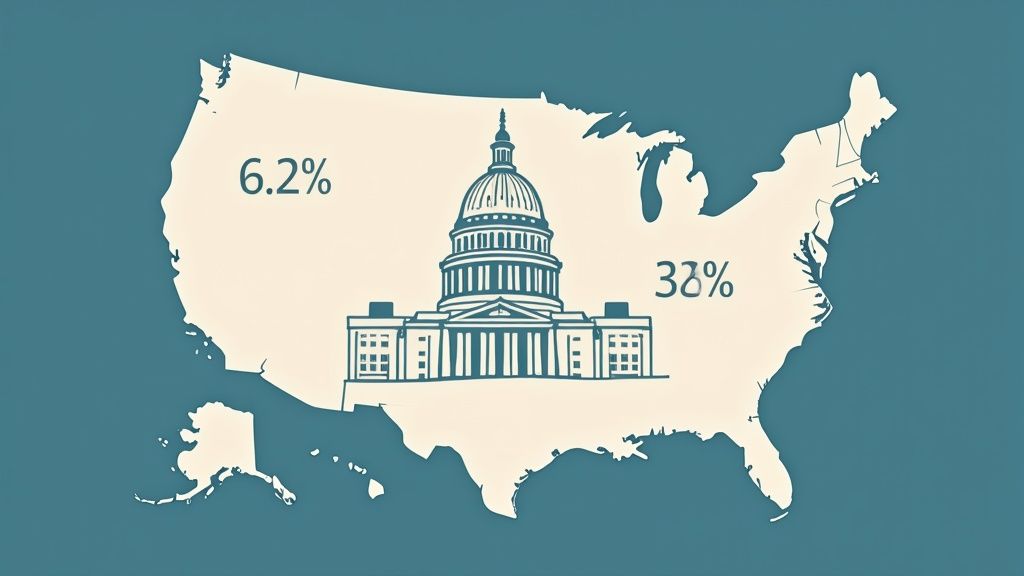
Let's be real. Payroll is where founder dreams go to die. One tiny mistake in withholding, one misclassified contractor, one missed state filing, and suddenly you’re getting friendly letters from the IRS that cost more than your last seed round.
I’ve been there. I’ve stared at spreadsheets at 2 AM, wondering if a single typo was about to force me to mortgage the office ping-pong table. It's especially brutal when you're hiring top-tier remote talent from different states or, God forbid, other countries. The rules change constantly, jurisdictions overlap, and the paperwork multiplies into an administrative monster.
After years in the trenches, I've learned you don't need a law degree to get it right. You just need a solid, no-fluff plan. This isn't your generic, bot-written advice. This is the battle-tested, founder-to-founder payroll compliance checklist I wish someone had handed me years ago. It’s built from real-world mistakes and hard-won victories. Let's dive in and tame this beast for good.
Getting employee classification right is the first, and arguably most critical, step. Screw this up, and you’re not just looking at a minor fine. You’re facing a cascade of back taxes, penalties, and lawsuits that make you wish you’d just stuck to selling lemonade. The core issue? Distinguishing between a W-2 employee (your team) and a 1099 independent contractor (a hired gun).
Misclassifying a worker isn’t an "oops." It’s a multi-million-dollar "oops." Just ask Microsoft, who paid out a staggering $97 million to settle a case. Or FedEx, which settled driver misclassification claims for a cool $319 million. These aren't just cautionary tales; they're expensive lessons in getting your classifications right from day one.
The IRS doesn't use a crystal ball. It uses a three-pronged test that boils down to one word: control.
This decision tree simplifies the IRS guidelines. Spoiler: it's not as simple as you'd hope.
The visualization shows that if you answer "Yes" to controlling two or more aspects of the work, you're firmly in W-2 employee territory. Navigating these distinctions is particularly vital when you go global. Learn the nuances of hiring freelancers in LATAM vs. full-time employees to avoid a very expensive international incident.
If employee classification is the foundation, then wage and hour law is the structural integrity of your payroll house. Ignoring the Fair Labor Standards Act (FLSA) is like building on a sinkhole. This federal law sets the rules for minimum wage, overtime pay, and recordkeeping. It’s the non-negotiable rulebook for paying your people.
Get this part of the payroll compliance checklist wrong, and you'll join an expensive club. Walmart had to settle for $65 million in overtime violations. Bank of America forked over $73 million. Even Papa John's paid out $16.5 million in a wage dispute. These aren't just big corporations with deep pockets; they're cautionary tales for any business that thinks "close enough" is good enough for payroll.

The Department of Labor doesn't mess around. A "we didn't know" defense won't save you. Here’s what you absolutely must get right.
To stay on the right side of the law, start by implementing automated time-tracking to eliminate human error. Regularly audit your classifications to ensure those you've marked as "exempt" from overtime truly meet the strict legal duties test. And for the love of all that is holy, train your managers. They are on the front lines and need to understand the rules.
Once you’ve figured out who’s an employee, the real fun begins: paying the tax man. Federal and state tax withholding is the part of your payroll compliance checklist where you play banker for the government, for free. Get it wrong, and you'll find out just how quickly the IRS can become your most persistent and least forgiving pen pal.

This process turns your payroll department into a high-stakes accounting machine. Companies like ADP and Paychex have built empires on automating this. Why? Because the key is removing human error from a system that demands absolute perfection.
Think of tax withholding as a puzzle where every piece must fit perfectly. One wrong move messes up the whole picture.
For employees without a Social Security Number, understanding alternatives like the ITIN is crucial. You can learn more about ITIN application requirements to stay compliant. This level of detail is what separates a smooth payroll run from a future audit nightmare.
So you've correctly withheld all that tax money. Don't get comfortable. You can't just let it sit in your bank account gathering dust. The government wants its cut, and it wants it on a strict schedule. This is where tax deposit and reporting requirements come in. Get the timing or accuracy wrong, and you’ll face penalties that make a late fee on a video rental look like a fond memory.
Think of it as the government's recurring subscription fee for employing people. And the IRS is not known for its leniency. Failing to deposit federal taxes on time can result in penalties from 2% to 15% of the underpayment. It’s a costly, and entirely avoidable, mistake.
The IRS doesn’t operate on a "pay when you feel like it" system. Your deposit schedule—either monthly or semi-weekly—is determined by your tax liability.
The complexity multiplies with a global team. Managing these varied deadlines manually is a recipe for disaster. This is why exploring effective payment solutions for remote workers in LATAM and other regions is crucial for maintaining compliance without losing your mind.
Don't get too comfortable after navigating the W-2 vs. 1099 minefield. The government wants to know about your new hire, and they want to know now. This isn't about being nosy; it's about child support enforcement and immigration law. Failing to report a new employee or verify their work eligibility is a surefire way to attract unwanted attention from agencies you really don't want to hear from.
Think of it as the government's official welcome wagon, except instead of a fruit basket, they bring forms and deadlines with teeth. It’s a foundational piece of your payroll compliance checklist that proves you’re not cutting corners.
The process is a tag-team effort between state agencies and U.S. Citizenship and Immigration Services (USCIS). You have two distinct but equally important jobs.
An internal audit that reveals a stack of incomplete or late I-9s is a compliance nightmare waiting to happen. For businesses tapping into global talent, understanding the legal considerations when hiring remote workers in LATAM can help you stay ahead of international requirements.
Navigating State Unemployment Insurance (SUI) is like trying to follow a different road map in every state you enter, except the roads are paved with paperwork and the speed limits are tax rates that change on you. Get it wrong, and you're not just lost; you're paying for it. This isn't an optional pit stop; it's a mandatory part of your payroll compliance checklist.
Ignoring SUI is a surefire way to bleed cash. Each state runs its own unemployment program with unique tax rates and rules. You can’t just apply your home state's rules across the board; that’s how you end up with a messy, state-by-state financial cleanup.
Your SUI tax rate isn't pulled out of a hat. It's your "experience rating," which is basically the state’s report card on your employee turnover. The fewer former employees who file successful unemployment claims, the lower your tax bill.
Effectively managing SUI is crucial, especially as you hire across different states. Diligent claims management isn't just good housekeeping; it's a strategic financial move.
Ignoring workers' compensation isn't just a compliance slip-up; it's like playing financial Russian roulette with your business. This state-mandated insurance is your safety net if an employee gets injured on the job. Without it, you’re personally on the hook for those costs, plus facing penalties that can shut you down faster than you can say "workplace hazard."
Failing to secure proper coverage is a high-stakes gamble. In New York, penalties can hit $2,000 for every 10-day period of noncompliance. Think that's steep? In California, it's a criminal offense that can land you in jail. These aren't scare tactics; they're the harsh reality of neglecting a fundamental part of your payroll compliance checklist.
Workers' comp premiums are not one-size-fits-all. They are heavily influenced by the risk of each employee's job, determined by a specific classification code.
Ensuring you have the right workers' comp coverage is non-negotiable. It protects your team and shields your company from potentially catastrophic financial liability.
| Item | Implementation Complexity | Resource Requirements | Expected Outcomes | Ideal Use Cases | Key Advantages |
|---|---|---|---|---|---|
| Employee Classification (W-2 vs. 1099 Compliance) | High due to subjective criteria and evolving relationships | Continuous monitoring, HR training, legal review | Reduced audit risk, correct tax withholding, legal compliance | Companies employing contractors and full-time workers | Protects against misclassification penalties and legal issues |
| Wage and Hour Law Compliance (FLSA) | Moderate complexity with exemption tests and tracking systems | Time tracking systems, manager training, audits | Accurate wage payment, compliance with wage laws, reduced lawsuits | Organizations with hourly and salaried employees | Protects employee rights, standardizes pay practices |
| Federal and State Tax Withholding | Moderate, requires frequent updates and multi-state knowledge | Certified payroll software, tax expertise | Correct tax withholding and deposits, compliance | Employers with multi-state employees, payroll departments | Reduces errors, maintains good standing with tax authorities |
| Payroll Tax Deposit and Reporting Requirements | Moderate to high due to multiple deadlines and forms | Automated deposit schedules, payroll software | Timely deposits and filings, penalty avoidance | All employers required to file federal and state tax reports | Streamlines deposits and filings, clear deadline management |
| New Hire Reporting and I-9 Verification | Moderate, involves regulatory understanding and documentation | Electronic I-9 systems, HR training, reporting automation | Legal workforce verification, compliance with immigration laws | Employers onboarding new employees regularly | Supports legal compliance and workforce documentation |
| State Unemployment Insurance (SUI) Compliance | Moderate complexity with variable state rules and experience ratings | Claims management resources, quarterly reporting | Proper tax payments, experience rating benefits | Employers subject to state unemployment taxes | Rewards low turnover, provides safety net for employees |
| Workers' Compensation Insurance Requirements | Moderate, involves insurance management and classification accuracy | Insurance brokers, payroll reporting, safety programs | Coverage for workplace injuries, reduced lawsuit risk | Employers with risk of workplace injuries | Protects employer and employee, encourages workplace safety |
Let’s be honest. You didn’t start your company because you had a burning passion for Form I-9 verification or a deep-seated love for calculating SUI rates. You started it to build something great. This payroll compliance checklist is your map through a minefield, but do you really want to spend your days navigating it yourself?
The truth is, while you can master this checklist, the more important question is should you? Every hour you spend wrestling with FLSA overtime rules is an hour you’re not spending on product, sales, or culture. It’s a classic founder trap: becoming the Chief Everything Officer and losing sight of the mission.
The details we've covered, from employee classification to workers' comp, aren't just bureaucratic hurdles; they represent massive legal and financial risks. Getting one detail wrong, like misclassifying a remote developer, can trigger a cascade of audits and penalties that no startup can afford.
Your key takeaways should be:
Look, you can follow this payroll compliance checklist to the letter and absolutely nail it. You can build the spreadsheets, set the reminders, and become an amateur expert in multi-state tax law. Or… you could just decide that’s a terrible use of a founder’s time. Your job is to build a great company, not to fact-check I-9s.
That's why we built LatHire. We didn't just want to connect companies with elite talent in Latin America; we wanted to handle the entire messy backend of HR, legal, and—you guessed it—payroll compliance. Our platform takes this entire headache off your plate. We handle the contracts, local tax withholding, benefits, and all the compliance so you can hire a world-class remote professional as easily as someone next door.
No more late-night compliance spirals. Just one platform to find, hire, and pay amazing talent. Toot, toot! A bit of a self-plug, I know, but we built the solution we always wanted. If you’re ready to get out of the payroll weeds and back to building, maybe it’s time to see how we do it.
